Are you ready for a world dominated by disruptive innovation?

Posted by 256
March 24th, 2016
Disruptive innovation is reshaping our world. But is your company standing on the beach trying to figure out why the tide has gone out so fast?
At DMX Dublin recently, Yuri van Geest opened his presentation with some remarkable and poignant footage of the scene on a beach in Thailand just before the tsunami hit in 2004. When the tide went out very far and very quickly, people wondered what was going on.
Mercifully, he stopped the video before it went too far.
Van Geest’s point was that the changes we are facing amount to a tsunami. If your company isn’t aware of what’s coming, then you may just be the equivalent of the unfortunates who were on that beach, trying to figure it out way too late to be able to do anything about it.
The scale of change that we are living through is extraordinary. But, as Shane Holland of Google once told me, ‘the rate of change we have lived through in the recent past is the slowest any of us are going to experience through the rest of our lives’. Yikes!
Is he wrong? Hardly. Just look at the growth rates for some of these technologies that are becoming more main stream as they become cheaper.
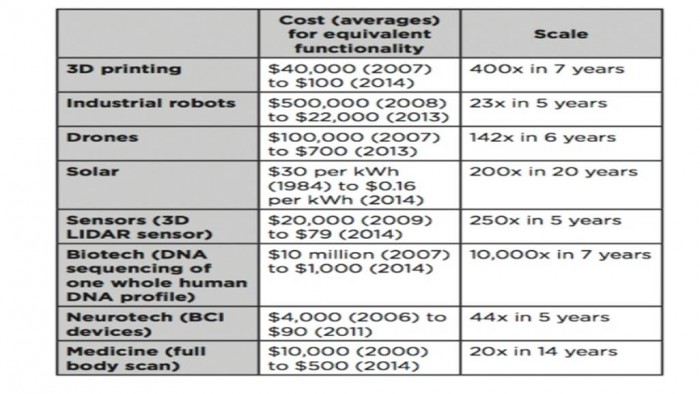
How many wireless engineers does it take to change a light bulb?
Soon a light bulb will create a lifi network that will replace our (almost full) wifi spectrum. Lifi will deliver near limitless capacity at 100 times the speed of wifi, up to 240 Gb/s in theory.
And, speaking of light, did you know that every organism emits a light source, unique in wavelength, duration, timing and rhythm? The light source emitted by our human bodies is 1000 times lower than the sensitivity of the human eye. But when we have scanners that can pick it up … just think of the changes that will bring forth.
Blockchain is a concept that will revolutionise online security and so much more.
Tesla has already proven the future of automotive lies outside of fossil fuels and if you think Google's autonomous cars are impressive, check out this Audi RS7 doing 150 mph with no driver.
Software is eating the world
Software is eating the world. Take a look at this Goldman Sachs graph of the estimated share of Capex by industry in the years 2014-2017.
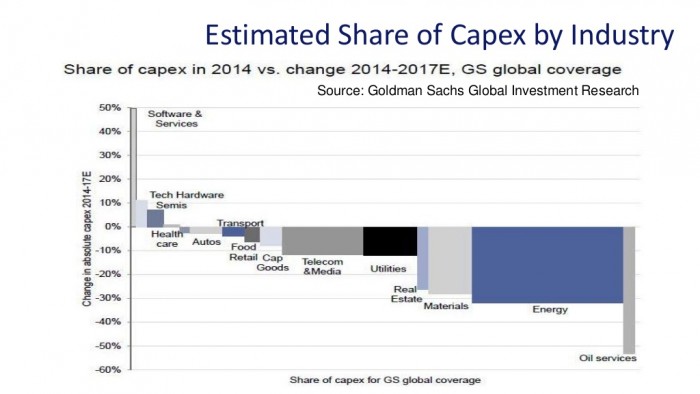
Kinda stunning to see the scale of growth of software and services versus everything else, isn’t it?
At 256 Media, we like to point out to prospective clients that they are in two businesses really – their own business and the business of publishing (that’s how important the creation of content has become).
But, in fact, they are in three businesses – because they are also in the business of software. Or at least, they should be. Marc Andreessen, founder of Netscape, maintains that ‘in the future, every company will become a software company’.
From disruptive innovation to 'Exponential Company'
For many massive companies, this dizzying rate of change has already had dramatically deleterious effects. The average life span of a Fortune 500 company has decreased from 67 years in the 1920s to 15 years today. In the next 10 years, 40% of all S&P 500 companies will disappear from this list.
In part, this is because we are seeing the growth of exponential (as opposed to linear) growth companies. These exponential companies are continuously shortening the time to scale.
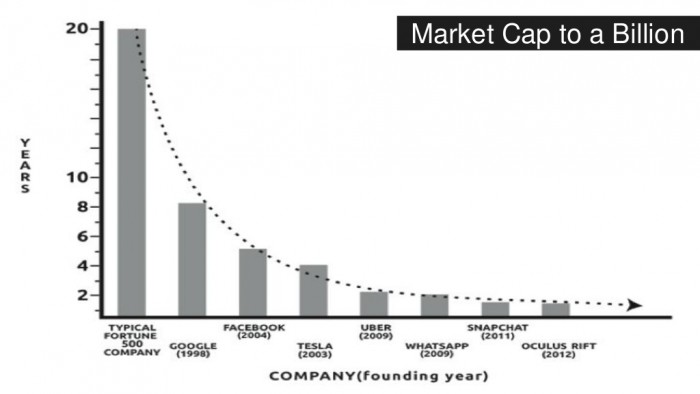
We see that the old linear ‘typical Fortune 500' company took 20 years to reach a market capitalisation of $1 billion. However, due to a number of factors, the time being taken to reach this point by exponential companies is getting shorter and shorter.
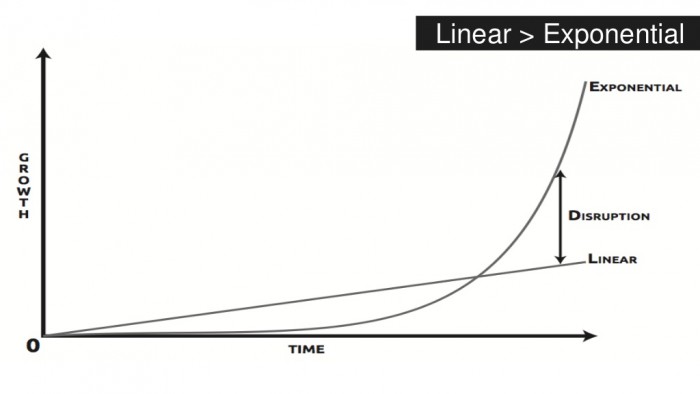
In the old linear model, companies grew by increasing their inputs and markets – ‘we will grow by X% if we open a new factory and launch a marketing campaign in Y market’. Exponential companies grow faster than that because the world has become one big online market and they have created huge demand by disrupting the paradigm in their market. But there is more to it than that, as they demonstrate an ability to scale up at enormous speed.
Definition:
An exponential organisation is one whose impact (or output) is disproportionally large – at least 10x larger – compared to its peers because of new organisational techniques that leverage exponential technologies.
The interesting part of this definition is the implication that it isn’t just the technology that qualifies a company as exponential, it is also their organisational techniques.
The role of 'Massive Transformative Purpose' in Exponential Companies
One of these techniques is the adoption of a ‘Massive Transformational Purpose’ – a higher, aspirational purpose of the organisation, capturing the hearts and minds of those both inside and (especially) outside the organisation. This becomes the guardrail for the development of the company.
Think Google, whose MTP is ‘organising the world’s information’ or TED with their ‘ideas worth spreading’.
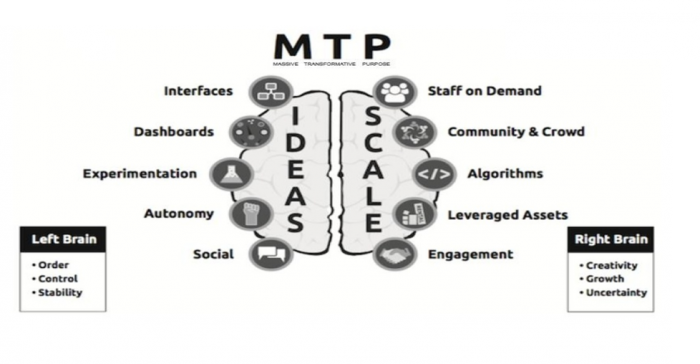
With a fresh start, exponential companies don’t have the legacy issues – such as IT, corporate structure and culture - that most linear companies have. They also have the freedom to create their own attributes, with the image above detailing their typical features.
I won’t go through all these in detail, but they do tend to make strong use of algorithms; devolve autonomy to lower order groups; foster a culture of experimentation; leverage their own internal and external communities; focus on design and usability and benefit from being able to scale up their workforce quickly by not conforming to standard employment contracts.
They also focus on engagement of those communities, with social being a significant channel for them.
Importantly exponential companies tend to create their strategies based on their Massive Transformative Purpose and customer insights, as opposed to simply extrapolating from what they have done in the past. And that alone is a pretty good reason to have a Massive Transformational Purpose.
Exemplar Exponential Companies
Van Geest cited a couple of example companies that demonstrate what he is talking about:
Github is an open source code and collaboration community with 6.5 million members, 14.2 m repositories and a market cap of $7bn. Their key differentiator is the way in which they leverage the community and crowd of coders to allow ‘social coding’. Github leverages its community, implements algorithms aggressively, and utilises staff/assets on demand to scale past its organizational boundaries.
Haier is a Chinese appliance maker with 80,000 employees, founded in 1984 and organised in 2,000 self-managed units with decision-making authority (autonomy). Their market cap has grown from $20bn to $60 bn in last 3 years. So why the massive recent growth? Well, apart from a focus on design, research and development and innovation, they changed their organisational structure in 2005 to create 2,000 self-managed units with decision-making authority, so developing a remarkable level of autonomy.
An example closer to home
To give an example close to this parish, we have a client, Hireday, that is a potentially exponential company. A start-up in the recruitment software space, they are just about to launch a disruptive technology that potentially revolutionises the way firms hire their staff.
Their Massive Transformational Purpose is to dramatically simplify the recruitment process (by doing away with the need to trawl through reams of CVs).
Their disruptive technology is centred on an algorithm that allows the platform, through a well-designed interface and easy to use dashboard, to deliver a picture of where each applicant for a job sits in relation to the profile of the ideal candidate.
Time will tell whether they go on to become an exponential company, but they have many of the attributes on the image above, including a focus on content to engage their community and crowd on social media.
There’s a lot of digital marketing in all of this stuff.
From a digital marketing perspective, there are a couple of key takeouts:
- You need to create a strong sense of purpose about your organisation. You may not feel that you are doing anything radically different, but if you can articulate it as ‘massively transformative’ in some sense, then you are more likely to resonate with your internal and external audiences.
- Being able to create engagement is very important. Particularly on social channels as that is where the growing audience is available.
If you would like help to understand this landscape, what the purpose of your content should be and how to create engaging content on an ongoing basis, then get in touch. We can’t promise to turn you into an exponential company, but we can certainly help you achieve your growth targets.

Previous Post
Pick the right Facebook contest winner with Agoro Pulse
Next Post

Is Google's personal assistant the future of search?
Subscribe Here
You may also like...
Nicole Thomsen | Dec 11, 2023
Nicole Thomsen | Nov 6, 2023
Nadia Reckmann | Nov 2, 2023





